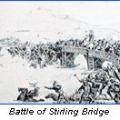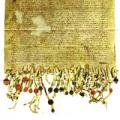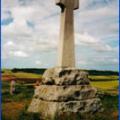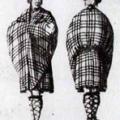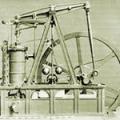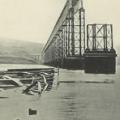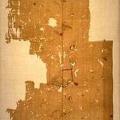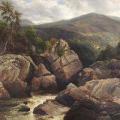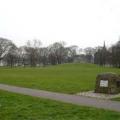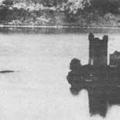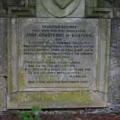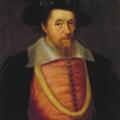Categories
Most Liked
Posted on July 17, 2013
by Amanda Moffet
by Amanda Moffet
Posted on May 12, 2013
by Chas Mac Donald
by Chas Mac Donald
Posted on August 29, 2013
by Amanda Moffet
by Amanda Moffet
Posted on February 6, 2013 by Donald | 3 views | comments
The Battle of Mons Graupius took place in 83 or 84. Julius Agricola, the Roman governor had sent his fleet ahead to panic the Caledonians, and, with light infantry reinforced with British auxiliaries, reached the site, which he found occupied by the enemy.
Even though the Romans were outnumbered in...
Posted on February 6, 2013 by Donald | 3 views | comments
With Malcolm II as king and Owen of Strathclyde supporting him, an important battle was fought against Earl Uhtred of Bamburgh and his Northumbrian army at Carham, near Roxburgh. The Battle of Carham (sometimes referred to as the Battle of Coldstream) is generally believed to have been fought in 101...
Posted on February 6, 2013 by Donald | 3 views | comments
Scotland was entirely submissive to England by 1296. Following English victories at Dunbar and Berwick, John Balliol had surrendered himself and was taken as a prisoner to England.
Edward I toured his new possession as far north as Elgin and removed the Stone of Destiny from Scone to take it back to...
Posted on February 6, 2013 by Donald | 3 views | comments
Before Pope John XXII, Scotland had been recognised as an independent nation by the papacy. Pope John preferred Edward II’s version of who was ruler of Scotland however, and in 1319 he accused four Scottish bishops of rebellion and summoned them to answer to him.
Robert I had been King of Scotland ...
Posted on February 6, 2013 by Donald | 3 views | comments
Flodden was a disastrous and unnecessary confrontation for Scotland. James IV of Scotland was married to the sister of England’s King Henry VIII and a treaty of friendship existed between their countries.
The auld alliance between Scotland and France had been recently renewed. There had been Englis...
Posted on February 6, 2013 by Donald | 3 views | comments
Following the Jacobite defeat at Culloden, the last pitched battle on British soil, Prince Charles fled to South Uist then eventually across to France.
His supporters who remained suffered terribly from ‘Butcher Cumberland’ and his medieval reprisals. To further punish Scotland, Parliament issued...
Posted on February 6, 2013 by Donald | 3 views | comments
James Watt, the son of a merchant, was born on January 19, 1736, in Greenock. He worked as a mathematical-instrument maker as a teenager and soon became interested in steam engines, which were used at the time to pump water from mines. His interest really took off in 1763 when he was given a Newco...
Posted on February 6, 2013 by Donald | 3 views | comments
Designed by Sir Thomas Bouch, the Tay Railway Bridge was opened in 1878.
The single-track bridge was a box construction with numerous box-section legs, up to 230ft apart, supporting the steam trains up to 88ft in the air as they snaked for almost two miles over the Tay and Perth-bound shipping. B...
Posted on February 6, 2013 by Donald | 3 views | comments
One of the most treasured possessions of the clan MacLeod is the famous Fairy Flag of Dunvegan. The story behind the flag is one of the greatest romantic tales in all the highlands...
A great young Chief of the clan MacLeod fell in love with a fairy princess, a bean sidhe, one of the Shining Folk...
Posted on February 6, 2013 by Donald | 3 views | comments
The end of 1688 saw much discontent with the Catholic monarchy, this was brought to a head when James's wife gave birth to an heir, William of Orange was invited to intervene. When William landed in England James was compelled to flee the country. William was crowned in his place. But not everyon...
Posted on February 6, 2013 by Donald | 3 views | comments
On the island of Eriskay in Scotland's Western Isles. There grows a small pink flower. Unique to the island this frail little Convolvulus flower has a link with Bonnie Prince Charlie.
Before he reached Glenfinnan to raise the Jacobite standard in 1745 the 'young pretender' first arrived at the is...
Posted on February 7, 2013 by Donald | 3 views | comments
Living in Edinburgh you are always aware that wherever you go you are trekking over centuries of history, that you can’t walk anywhere without walking on ancient bones. However in our little office in Leith we were completely unaware of the history right under our feet.
King James V died in 1542 ...
Posted on February 7, 2013 by Donald | 3 views | comments
Returning to Iona from his mission to Christianise the Picts, Saint Columba approached one of the crossing points of the River Ness. There was a small settlement here, and a group of people were digging a grave for a newly dead man. When Columba asked how the man had died he was told he had been kil...
Posted on February 7, 2013 by Donald | 3 views | comments
The Armstrong Clan has been without a chief for over 450 years, the story behind this is one laced with intrigue, murder, piracy and even hidden treasure. The stuff movies are made from.
The story is set around Johnnie Armstrong of Gilnockie and the Border Reivers in the 16th Century. Johnnie Arm...
Posted on February 7, 2013 by Donald | 3 views | comments
James VI and I was King of Scots, King of England, and King of Ireland and was the first to style himself King of Great Britain. He ruled in Scotland as James VI from 24 July 1567. Then from the 'Union of the Crowns', in England and Ireland as James I, from 24 March 1603 until his death. He was t...
Featured Articles
Most Discussed
Posted on July 16, 2013
by Amanda Moffet
by Amanda Moffet
Posted on February 6, 2013
by Donald
by Donald
Posted on July 17, 2013
by Amanda Moffet
by Amanda Moffet


 View More
View More View Less
View Less

